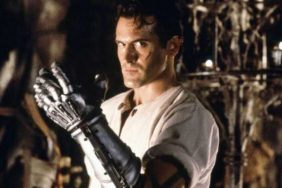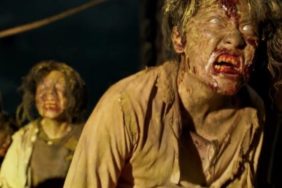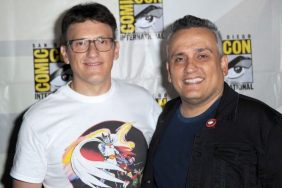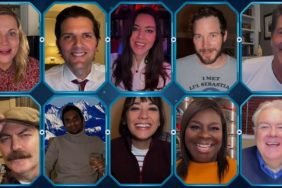
Thanks to a small oversight on the part of the filmmakers (they forgot to include a copyright notice on the film), Night of the Living Dead lapsed into the public domain, and was, as a result, played endlessly for free throughout the nation’s grindhouses. Sadly, Romero has not seen any profit from his famous film, and, since anyone can put out a copy, cheap and crappy-looking home video copies can still be found in any drugstore. The film’s proliferation, however, had it grow in cult cache for years, and it became one of the most-seen horror films of all time. In the 1970s, at the beginning of the midnight movie boom, it moved into regular rotation alongside hits like El Topo and Pink Flamingos. It is considered one of the “big six” of the midnight movie canon (the others include Eraserhead, The Rocky Horror Picture Show, and The Harder They Come).
Thanks to the time-release big hit of Romero’s film, zombies exploded. The late 1970s saw hundreds of zombie films, and it’s no wonder. Zombie films could be made on a small budget, didn’t require big stars or complex screenplays, or even extensive special effects. All you needed was enough makeup to cover however many extras you required, and maybe a few quickly-purchased pig entrails to drape across your victims.
The late 1970s were also a time of severe political and social uprising, and zombies have been seen variously to represent whatever pet cause may be lurking in the world. The original Night of the Living Dead, with its black protagonist, has been accused of being a racial parable, the zombies standing in for encroaching hatred. Romero’s eventual follow-up to Night, 1978’s Dawn of the Dead, easily his best film, is often seen as a parable for rampant over-consumerism; the zombies in the film find themselves wandering through a shopping mall, presumably because it was the only place they felt comfortable in life. Romero continued his Living Dead series into the modern age with increasingly blunt political messages. In 2005’s Land of the Dead, zombies were cordoned off from humans as if they were a lower class. It’s a zombie version of an Occupy movie. 2009’s Survival of the Dead has been called a version of the Hatfields and the McCoys. Zombies have been politically reinterpreted more often than Godzilla.

When did the zombie bite first transfer zombie virus into you, making you into a zombie? I think that would be Dawn of the Dead.
In the 1980s, the effects on zombies became more and more wild, and the politicization became more varied. With films like Dan O’Bannon’s The Return of the Living Dead (not part of Romero’s Living Dead series) from 1985, zombies were seen as more fashionable and punky, perhaps making them a metaphor for a generation or class gap. It was in the 1980s that zombies first became hungry for brains in particular, and The Return of the Living Dead was the first flick to have the oft-repeated “braaaaainsss” refrain. Zombie films of the 1980s, however, quickly became a spoof of their immediate forebears, and a lot of the Living Dead films from the era feel jokey and odd. This was during the golden age of the horror comedy, and a lot of the films that O’Bannon wrought (alongside films like Stuart Gordon’s Re-Animator and their kin) were terrifying, but also raucous and naughty. Zombie films from the 1980s are of their own flavor.

The pinnacle of zombie comedies came in 1992 with Peter Jackson’s Braindead, released in the U.S. as Dead Alive. Easily one of the goriest films of all time, Dead Alive is the reason horror fans use words like “splatstick.” When a Sumatran rat monkey bites a New Zealand mum (Elizabeth Moody) it’s up to her henpecked son (Timothy Balme) to clean up after her. She begins biting and transforming others, and the results of the zombie attacks are revolting. People’s lips are eaten, ribcages are removed, people are fed into cusinarts, dogs are regurgitated, a disembodied colon attacks people. This film has everything a zombie fan could want, all under a weird-ass lightweight comedic tone. Jackson has come to be the staid and steady master of overdesigned CGI blockbusters, but there was a time when he was a cult director through-and-through. I hope that someday he’ll get back to his roots, and make something off-the-wall again.
In the 2000s, horror films turned grisly, and torture was a big element of many of the films of the decade. Zombies, you would think, would fit easily into this milieu (and it does in a film like 2002’s 28 Days Later, which stages the zombie apocalypse like a distinct post-9/11 disaster), but I think the jokey tone that hangs over the genre dictated that most zombie films be high-octane and kind of campy. Movies also began to resemble video games in many respects, so zombies came to be seen as a kind of chattle for the heroes to dispatch by increasingly violent or creative means. They were the grunts, the goombahs that have no personality, face, or genuine threat. Films like Planet Terror, Land of the Dead, Zombieland , the remake of Dawn of the Dead, and most especially the comic cult classic Shaun of the Dead, began to reveal why people were to become wholly obsessed with zombies. Zombie offered up the ultimate power fantasy.

It goes something like this: As a survivor of the zombie holocaust, you find yourself in a world where rules no longer apply to you. You may go where you want, steal what you want, and not have to worry about relationships or jobs or anything other than looting and gathering. Politics and philosophy and basic human interaction? Gone. Also, you get to have a lot of weapons, both blunt and projectile. The zombie apocalypse fantasy ties directly into a casual misanthropy that seems to bubble up under a lot of the young peoples’ ethos. You can be alone, own weapons and, perhaps most importantly, violently shoot, stab, and murder anyone you like, all in the name of righteousness. You can enact your violent revenge fantasies on a zombie, because they are a zombie. The zombie apocalypse fantasy allows you to be a grumpy lone murderous misanthrope, and treat that like its a noble endeavor. Your antisocial and violent fantasies are now doing the world a service.
Seeing as how video games have come to dominate a lot of popular culture, the notion of shooting through a team of useless human-shaped targets has become an indelible part of this generation’s thinking. Zombies are the handiest generic “bad guy” of the day. Sure, films like Warm Bodies try to make zombie sympathetic, but for the most part, they are targets. Zombies can be scary, but there is also an element of sportsmanlike fun to them. Zombies represent survival, power, and fun. I suppose it’s no wonder that they have endured.
Homework for the Week:
What are your favorite zombie movies? Do you like zombies? Why are they so appealing? Have you ever had a zombie fantasy? Do you play zombie video games? How do they rate as monsters? As villains? As targets? Do you like slow zombies better, or fast ones?
Witney Seibold is a featured contributor on the CraveOnline Film Channel, co-host of The B-Movies Podcast and co-star of The Trailer Hitch. You can read his weekly articles B-Movies Extended, Free Film School and The Series Project, and follow him on “Twitter” at @WitneySeibold, where he is slowly losing his mind. If you want to buy him a gift (and I know you do), you can visit his Amazon Wish List.






